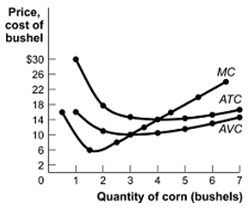Problem 1. Suppose the Chicago Cubs could rent out Wrigley Field (the field the players play on) to local youth leagues for $11,000 per month. The $11,000 per month reflects the ______ of capital.
A) implicit cost
B) explicit cost
C) direct cost
D) total cost
Problem 2. When a cherry orchard in Oregon adds an additional worker, the total cost of production increases by $24,000. Adding the worker increases total cherry output by 600 pounds. Therefore, the marginal cost of that worker equals:
A) $40.
B) $19.
C) $4,000.
D) $24,000.
Problem 3. Lauren has 11 people working in her tangerine grove. The marginal product of the 11th worker equals 13 bushels of tangerines. If she hires a 12th worker, the marginal product of that worker will equal:
A) 14 bushels.
B) 15 bushels.
C) 12 bushels.
D) The answer cannot be determined with the information available.
Problem 4. You run a business producing picture frames. This month your total cost of production is $10,000, your variable cost of production is $6,000, and you produce 3,000 picture frames. It follows that:
A) average variable cost is $2.
B) average total cost is $3.
C) average total cost is $1.
D) average fixed cost is $1.
Problem 5. One characteristic of a perfectly competitive market is that there are ______ sellers of the good or service.
A) 1 or 2
B) a few
C) usually less than 10
D) hundreds or thousands
Problem 6. (Figure: Cost Curves and Profits) The market for corn is perfectly competitive, and an individual corn farmer faces the cost curves shown in the accompanying figure. If the price of a bushel of corn in the market is $14, then the farmer will produce ______ of corn and earn an economic ______ equal to ______.
A) 4 bushels; profit; $0.
B) 4 bushels; profit; just less than $80 per bushel
C) 2 bushels; profit; $0
D) 2 bushels; loss; just more than $80 per bushel

Problem 7. Prof. Dumbledorr has a monopoly on magic hats. The large barriers to entry in the magic hat industry is the reason why Dumbledorr's monopoly:
A) earns an economic profit in the long run.
B) produces at the minimum average total cost in the long run.
C) produces with no fixed costs in the long run.
D) maximizes its profits by producing where P = MC.
Problem 8. A natural monopoly is one that:
A) monopolizes a natural resource such as a mineral spring.
B) is based on control of something occurring in nature (such as diamonds).
C) has economies of scale over the entire relevant range of output.
D) typically has low fixed costs, making it easy and “natural” for it to shut out competitors.
Problem 9. If there are two gas stations in the town of Smalltown, then the gasoline industry in Smalltown is probably best characterized as:
A) perfect competitive.
B) monopolistic competitive.
C) monopolistic.
D) oligopolistic.
Problem 10. Monopolistic competition is similar to perfect competition in that firms in both market structures:
A) are price-takers.
B) produce goods that are perfect substitutes.
C) find it beneficial to advertise.
D) do not face any barriers to entry into the industry in the long run.